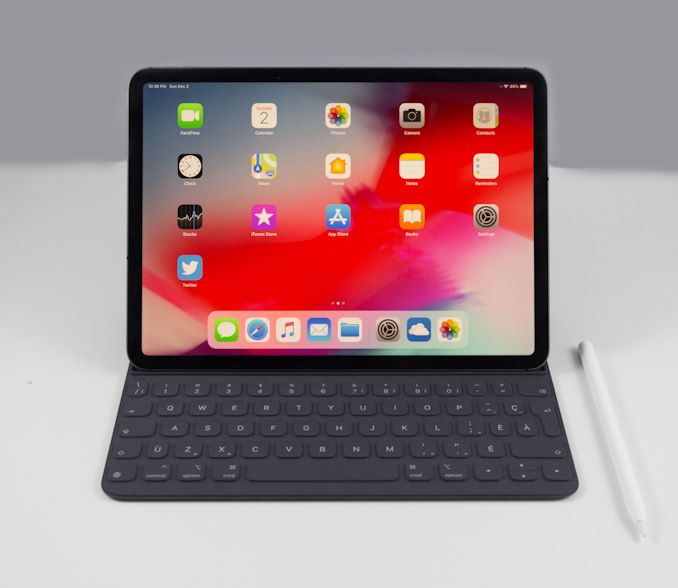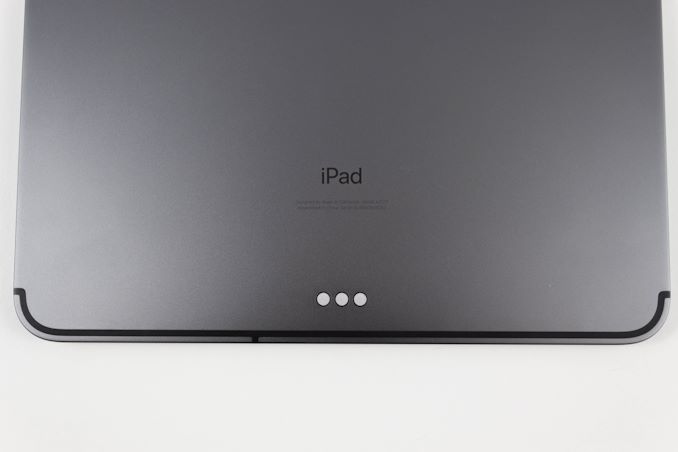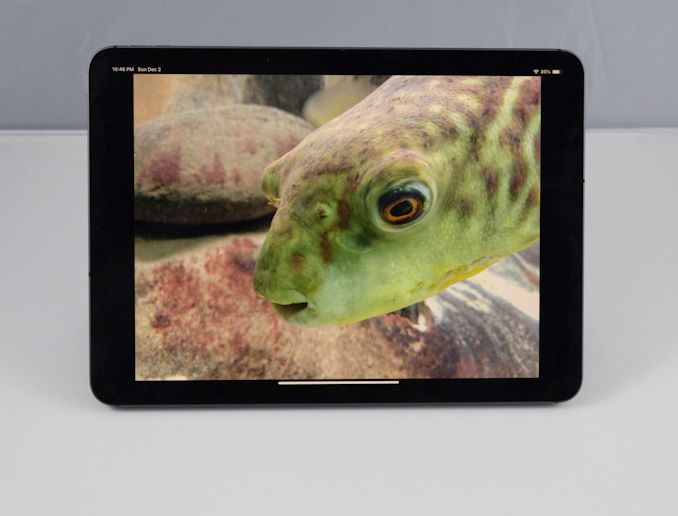The 2018 Apple iPad Pro (11-Inch) Review: Doubling Down On Performance
by Brett Howse & Andrei Frumusanu on December 4, 2018 10:00 AM ESTFinal Words
Apple calls the 2018 iPad Pro the iPad they’ve always dreamed of building. The new iPad Pro offers a completely new design, with some great new features, so it’s not difficult to see why they say that. The first thing anyone will notice is the new thinner bezels, offering up a modern take on the iPad idea.
Let’s start with the display, since it is really a highlight of this iPad. The performance of it is simply outstanding, and Apple offers arguably the best display in any consumer device with the iPad Pro. The 120 Hz ProMotion makes scrolling incredibly smooth. The True Tone adjustment brings a pleasant look to the display in any lighting condition. And the color accuracy is pretty much second to none. Really the only thing missing is HDR – and the battery life hit that would entail in such a portable device would probably not be worth it.
Apple’s SoC efforts have been leading the industry, and the A12X in the iPad Pro offers plenty of performance, but without breaking the power budget. With four Vortex cores for performance, coupled with four Tempest cores for efficiency, and all eight cores available all the time, you get both the burst performance needed for everyday workloads, along with the incredible battery life you’d expect in a tablet. On the GPU side, the seven GPU cores offer 75% more GPU hardware than the iPhone XS, and more memory bandwidth as well. The GPU and CPU both share the sameLPDDR4X memory, with up to 6 GB, and the performance is excellent.
Apple’s new Pencil is also a nice improvement over the outgoing model. A small thing like one flat side makes the Pencil not roll away on you, and also doubles as a connection to the iPad Pro where it magnetically docks for charging. It is a much-improved design over the original, and it is double improved by having a capacitive button on near the tip which can do various functions depending on the application being used.
The new Smart Folio Keyboard is also a nice improvement, offering a much easier setup, but it is not as clear of a win as the Pencil. The extra slot for a second position is nice, but it makes the iPad a bit wobbly and unstable if used anywhere but a nice, flat desk. The keys also don’t offer backlighting, and the definitely should for the price. iOS also shows from time to time that it was not originally intended to be used with a keyboard, which can be frustrating.
And while the hardware is fantastic, iOS is starting to feel like it is holding back the iPad Pro in the productivity realm. There is a lot of performance on tap, but getting access to it can be difficult. It really comes down to the app developers to pull the performance out of this iPad, but due to the fragmented iPad market, they may just target the lowest common denominator, which is often the case. A game like Civilization VI comes by default running at a very low resolution so that it will work well with the older iPads Pros, and will take a developer update to unlock any more fidelity, since the end user has no control over that on iOS for the most part. It makes it easy, but it isn’t always the best experience.
At least on an app basis, the silver lining here is that Adobe bringing their Creative Cloud suite to the iPad is definitely a big win for Apple. Done well, and it should showcase the performance of the tablet, along with the Pencil, in ways that many other apps won’t take advantage of.
If you are a fan of iOS, and you have a workflow that is suited to its operation, there’s little doubt the new iPad Pro models are going to be a great addition, but considering the price increase over the base iPad, you really have to need that performance to justify the iPad Pro 11-inch. Apple also charges a pretty hefty sum to upgrade the internal storage, and the accessories really add on to the price tag as well.
With all of that said, there’s no doubt in my mind that the latest iPad Pro is the best iPad ever. It’s the fastest. It offers great battery life. The display is second to none. But it is still, at its nature, an iPad. Apple has been working on the productivity angle for a few generations now, and while this is their best stab at it yet, the iPad Pro is still in that awkward gap between a content consumption device and a traditional laptop or the Windows convertibles that the original iPad inspired. What you get then is a device that's certainly a lot more professional than the base iPad and a lot more useful for productivity use cases, but also something that feels more like a larger, more expensive iPad than the kind of top-tier machines the iPad Pro is intended to compete with.













145 Comments
View All Comments
Hyper72 - Tuesday, December 4, 2018 - link
There are definitely lots of use cases where it can't beat laptops but saying it's just a large iPhone is disingenuous at best. It's all about use cases and what the individual person needs.MonkeyPaw - Tuesday, December 4, 2018 - link
I think we may find out soon enough if/when Apple migrates to its own SOCs for MacOS hardware.tipoo - Tuesday, December 4, 2018 - link
Can't wait.Look what it trounces with barely any cooling. Now give it a less constraining OS and heatpipes and fans and let's see what it can do.
Spunjji - Wednesday, December 5, 2018 - link
I disagree with you only in that I don't think Apple will ever want to add fans to this. Heatpipes, perhaps, but even then they've been tending on a "slimmer and lighter is better" trajectory for a long time. I imagine the first MacBook to run from a descendant of this SoC will be fanless and trumpeted as the lightest ever, silent, no dust issues, etc.tipoo - Monday, December 10, 2018 - link
Macbook and Macbook air, sure, go for it, but I hope the Pros retain active cooling, no matter how efficient the chip it still allows higher performance, plus with how GPUs scale with wattage for the 15". I hope they retain the 35W+35W chip setup and that should still mean fans.ChrisH362 - Tuesday, December 4, 2018 - link
In the article you mentioned “A more telling test, perhaps, will be once Adobe has ported over the full-fat version of Photoshop to the iPad, which is expected next year.” Instead of waiting on Adobe why not use Affinity Photo from Serif to perform some benchmark tests? The have working versions for Mac, Windows, and IPad. Their application works just as well, if not better in some areas as Adobe. https://affinity.serif.com/en-us/MonkeyPaw - Tuesday, December 4, 2018 - link
Affinity runs far better on my 2017 iPad Pro than my 2017 5K iMac. I can develop RAW on each, and the sliders are near instantaneous on iPad, but seriously slow on MacOS. Side by side, you’d swear two different developers made these apps, despite looking very similar.tipoo - Tuesday, December 4, 2018 - link
Sounds like a port thing, as this article demonstrates when going the other way things aren't perfect either. Affinity is mobile first.thunng8 - Tuesday, December 4, 2018 - link
That's incorrect Affinity photo was developed for mac and windows before the ipadSpunjji - Wednesday, December 5, 2018 - link
Which GPU does your iMac have? It's worth knowing as this may primarily be a function of performance scaling. You're asking the iMac to render 4x as many pixels as the iPad, and depending on your GPU it may be much less efficient than the iPad at moving that much information through its memory.Not arguing that performance is impressive here, just that the iMac may not be doing as badly as all that in comparison.